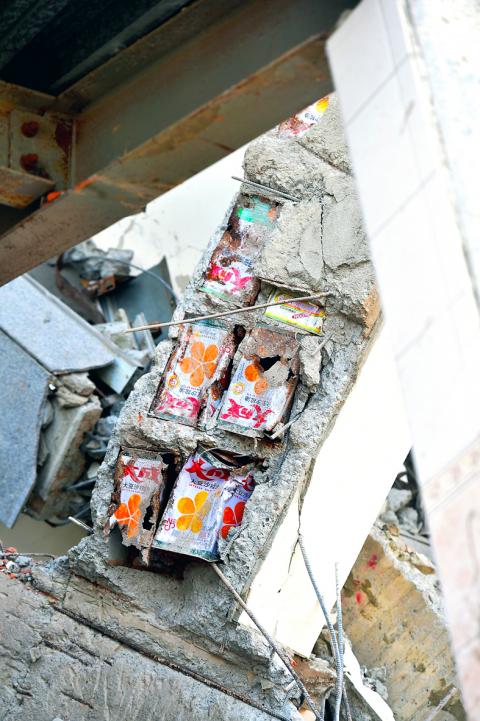8 February 2016
Taking responsibility for disaster risk reduction
Posted by Dave Petley
Taking responsibility for disaster prevention
Disaster prevention, regardless of the peril, works through many small actions by individuals, every one of whom must take individual responsibility. To achieve a genuine increase in resilience requires dedication, coordination and determination, based on sound judgement, good science and (in many cases) high quality engineering. Sadly, the flip side of this is that individuals can undermine the efforts of everyone else, and in so doing turn a survivable incident into a disaster.
The case of the Taiwan earthquake appears to be a good example. The collapse of the Weiguan Jinlong apartment complex should not have occurred – a building of this type should have been able to withstand the peak ground accelerations associated with an earthquake of this magnitude, even allowing for the potential for some amplification from the sediments under the foundation. The collapse is quite odd in many ways – the building has clearly toppled over. But over the last day or so images have emerged of the state of the key columns that supported the building, and the images are shocking:

Tin cans within the structural columns in the Weiguan Jinlong apartment complex in Taiwan (via China Foto Press)
.
The apparent replacement of structural concrete with empty cooking oil cans may have critically weakened the building, and if these are load-bearing may have played a role in the failure. The cans provide almost no structural strength, and of course mean that the amount of rebar within the concrete is also reduced. Interestingly, there is surprisingly little rebar in the section of the column that does have concrete.
And this column is not alone. This Taipei Times image shows a double layer of cooling oil cans:

Cooking oil cans in columns in the Weiguan Jinlong apartment building collapse, via the Taipei Times
.
And of course if this was going on it is likely that there were other problems with the building too, and these problems may have been the real cause of the collapse. The irony is that the saving here was not huge in the context of the cost of the building – some rebar work, some cubic metres of concrete. But this is not the action of one person – to place cooking oil cans in the columns like this would have required the collusion of several individuals at least.
Meanwhile, in Brazil the investigation into the Samarco tailings dam disaster that devastated Bento Rodrigues late last year continues. This will be watched with keen interest – the mining industry has a wretched track record with tailings dam failures – I cannot think of any other engineered structure that has such a high failure rate, especially in light of the devastating consequences. The Brazilian government is now estimating that the impact of the failure, excluding the environmental costs, are now over $300 million. And for once the authorities are responding by taking a very hard line. Telesur reported as follows last week:
Brazilian authorities said they have gathered enough evidence to charge Brazilian mining executives with murder after 19 died in the tragedy. Brazilian police authorities announced Friday that they have gathered “sufficient evidence” in order to charge high-ranking executives from Brazilian mining companies with murder, following the aftermath of the November 2015 dam burst in Minas Gerais state. “We have gathered all of the findings from the autopsy reports, in which we determined that the crime of murder had been committed,” said Rodrigo Bustamante, who has been heading up the investigation for the state’s civil police.
A charge of murder will raise eyebrows for sure. I cannot comment on the likely outcome of the case, but such strong legal action should force mining executives to start to take proper responsibility for their tailings dams. That must be a good thing.
If we are to reduce losses from natural hazards, whether they are earthquake, landslides or floods, then there is a need for individuals to take responsibility.


 Dave Petley is the Vice-Chancellor of the University of Hull in the United Kingdom. His blog provides commentary and analysis of landslide events occurring worldwide, including the landslides themselves, latest research, and conferences and meetings.
Dave Petley is the Vice-Chancellor of the University of Hull in the United Kingdom. His blog provides commentary and analysis of landslide events occurring worldwide, including the landslides themselves, latest research, and conferences and meetings.
And the rebar!
Verticals don’t look much bigger than #3 or #4.
Chicken wire would’ve done a better job.
This is the level of criminality that sends chills up my spine.
Too bad this wasn’t in mainland China. Heads would literally be rolling.
I don’t think it is clear what we are seeing. Those don’t look like load bearing elements to me.
Also, there appears to be great care in putting the cans in the wall. Those cans are very evenly spaced, and are securely fastened. Otherwise they would have “floated” when the concrete was poured.
Perhaps they are there to reduce the load on the structure. This is done frequently in some cases, like in precast concrete beams.
An excellent point. Maybe installed as semipermanent partitions between apartments?
Awesome post. Very helpful advice within this post! It is the little changes which will make the greatest changes. Thanks for coming with good informational blog keep the good work going.